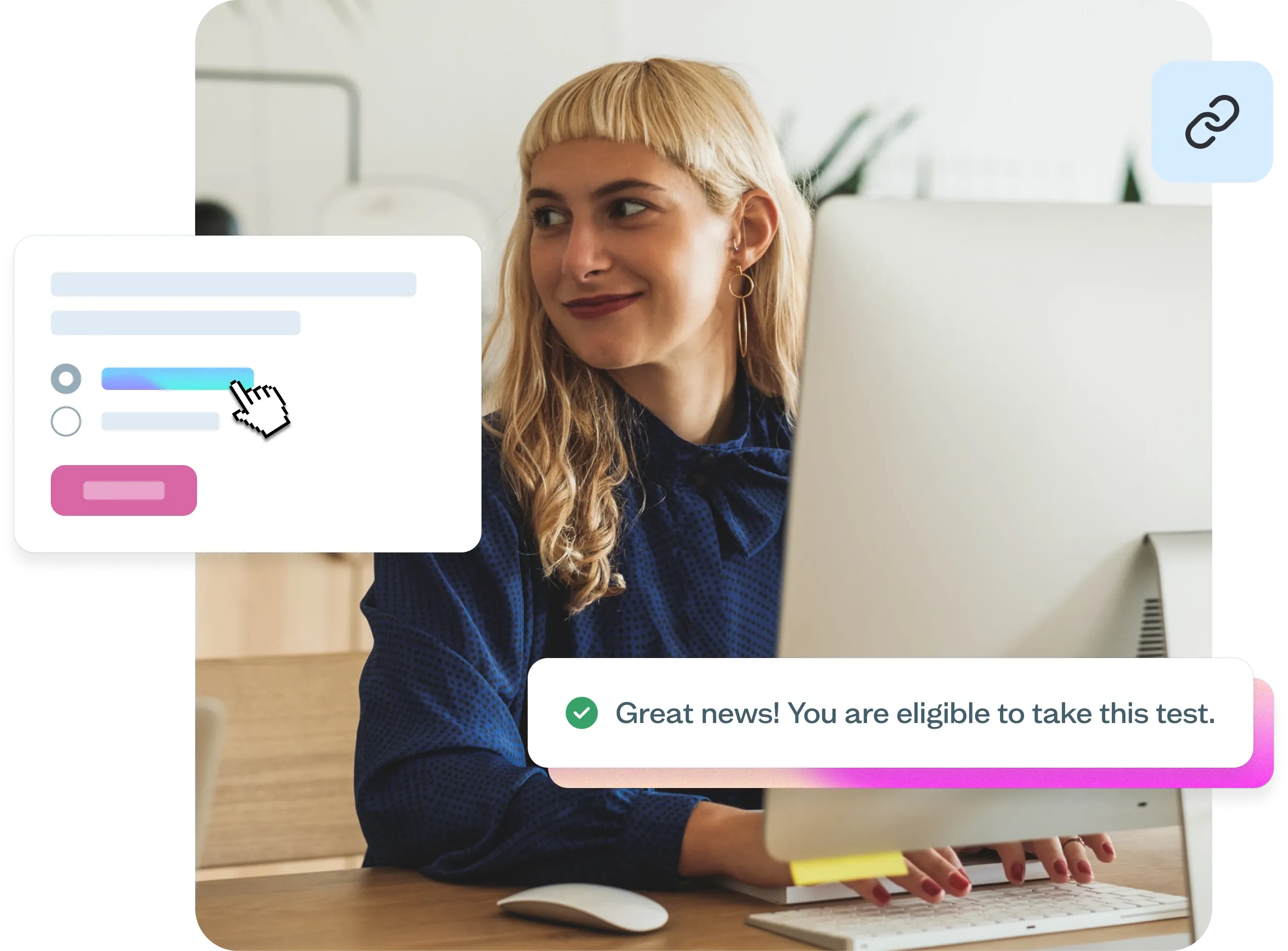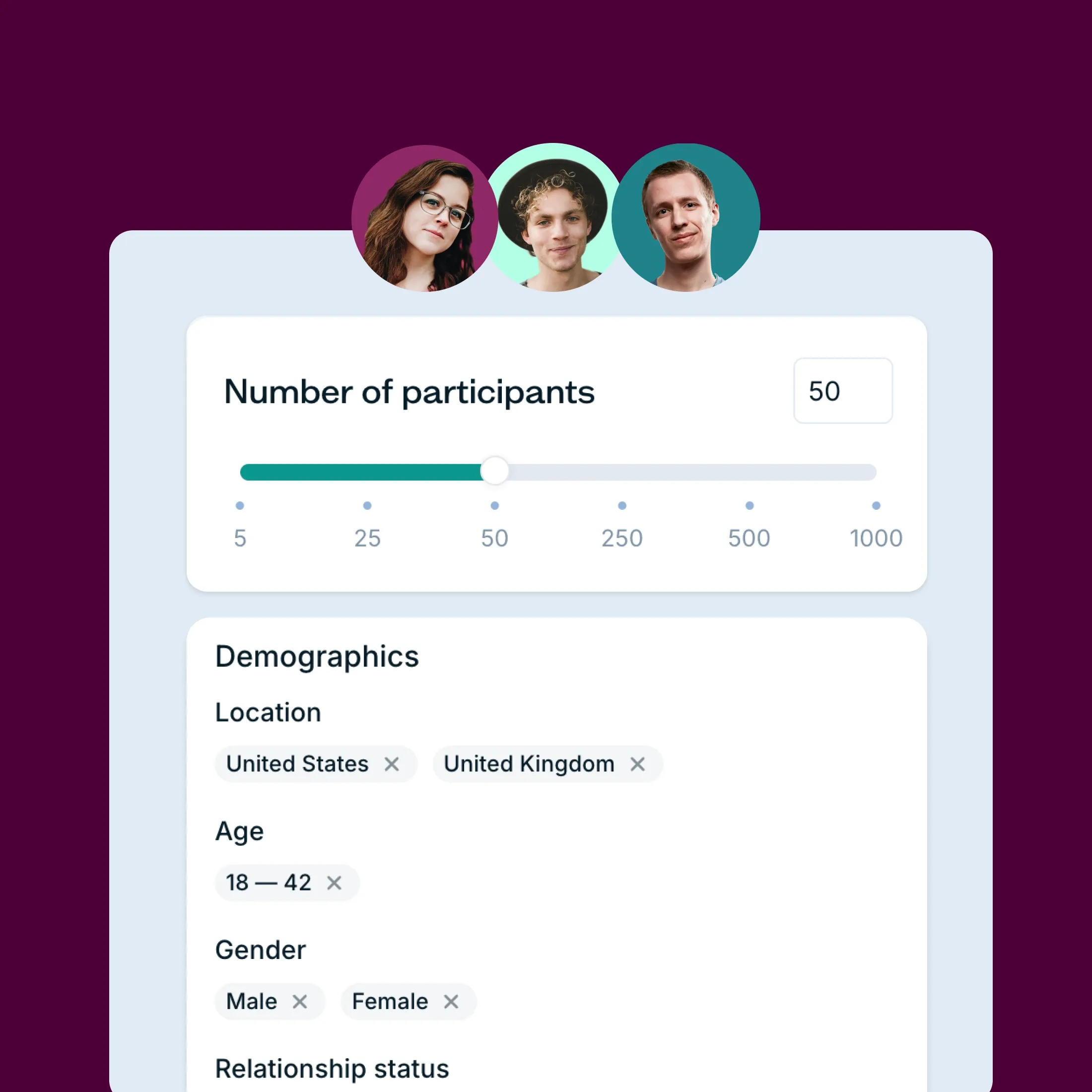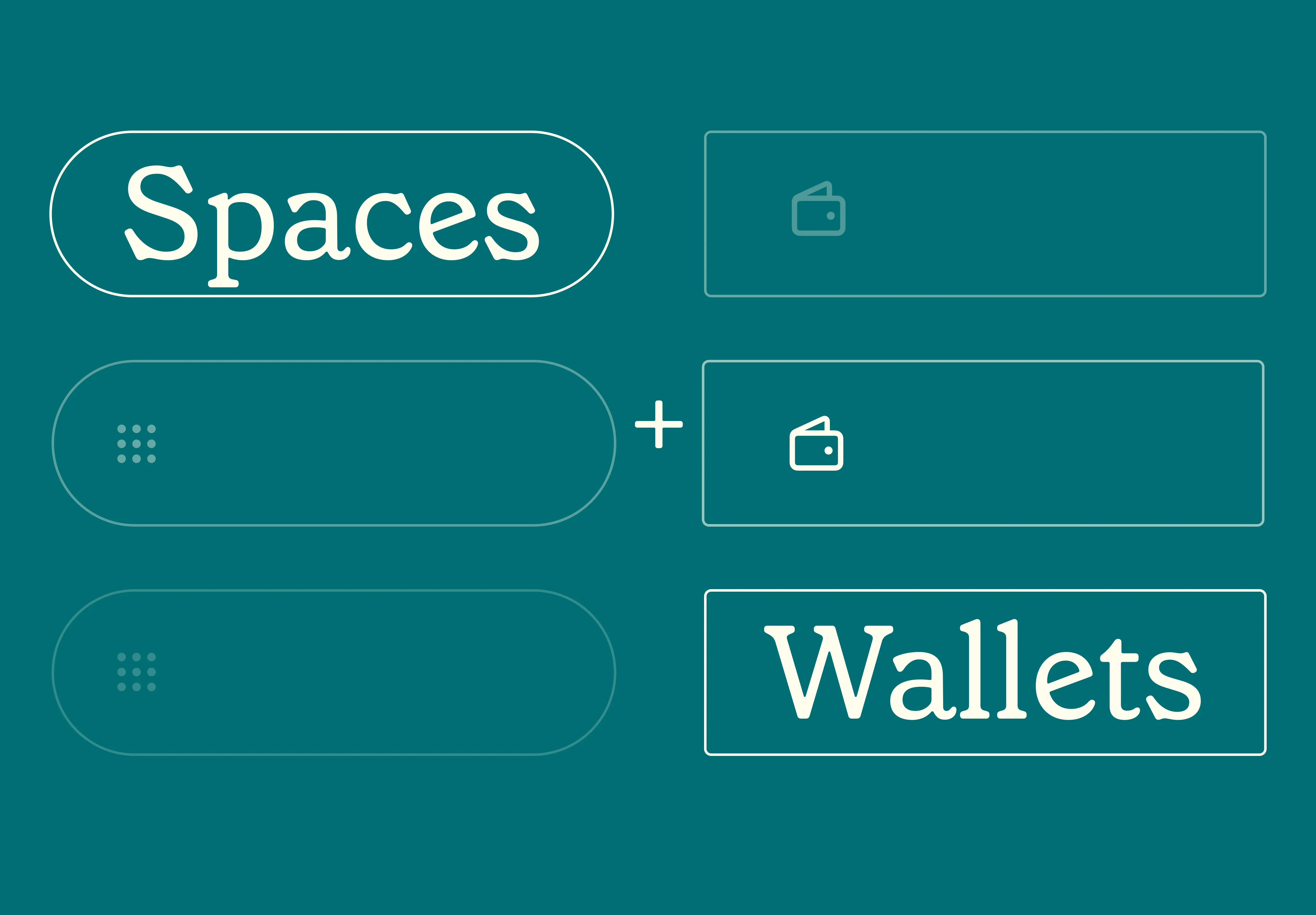18 Nov 2025
|23 min
14 best UX survey tools
Explore 14+ top UX survey tools to gather insights, improve user experience, and optimize product design. Find the right tool for your research needs.

Choosing the right UX survey tool isn’t just about picking one with the most features or the prettiest interface. It’s about finding a tool that’s going to streamline your workflow, gather the right data, and actually make your life easier.
The key is to focus on functionality, speed, and ease of use.
You don’t want to spend your time wrestling data that looks like something from the Da Vinci Code when you could be using that time to refine your product.
This guide will save you all that number-wrangling and head-banging. We break down the top UX survey tools on the market, their main features, and (of course) their price, so you can make your choice with confidence and speed.
Please note: All prices displayed in this article are in USD
How to choose a UX survey tool
The right tool needs to align with your goals – whether it's gathering quick feedback, analyzing in-depth qualitative data, or running continuous usability tests. When evaluating your options, consider these key features:
Ease of use: The best tools should be intuitive, allowing you to create surveys quickly without technical expertise. A simple interface saves you time and makes sure your team can adopt the tool with minimal training.
Customization options: Does the tool let you tailor questions to specific user groups? Customizability is essential if you need in-depth feedback from different segments of your audience.
Recruitment capabilities: If you don’t have a ready pool of participants, you’ll need a tool with built-in recruitment features. Look for platforms that offer access to diverse, reliable panels so you can quickly gather responses from relevant user demographics.
Data analysis tools: Beyond just collecting responses, a good survey tool will help you analyze data effectively. Tools with built-in analytics, real-time reporting, or integrations with your existing platforms can help you turn insights into action.
Affordability: Budget constraints are always a concern. Compare the cost of various tools, considering free plans and whether paid features offer significant value for your specific needs.
TL;DR: A quick glance at the 14 best UX survey tools
Tool | Best for | Pricing |
|---|---|---|
Lyssna | Comprehensive UX research with participant recruitment | Free plan available; paid plans start at $82/month. Panel responses priced separately. |
Typeform | Engaging and interactive forms | Free plan available; paid plans start at $29/month. |
Condens | Organizing and analyzing qualitative data | Individual plans start at $15/month; team plans start at $190/month. |
SurveyMonkey | General-purpose surveys | Individual plans start at $32/month; team plans at $23/user/month (min. 3 users). |
Jotform | Customizable forms with design flexibility | Free plan available; paid plans start at $34/month. |
Qualtrics | Advanced surveys and enterprise-level research | Custom pricing; contact sales for details. |
Alchemer | Flexible survey customization | Basic plans start at $55/month. |
SurveyLegend | Visually appealing surveys | Free plan available; paid plans start at $25/month. |
Google Forms | Simple, no-frills surveys | Free for all users. |
Microsoft Forms | Integration with Microsoft 365 | Free for Microsoft 365 users. |
Survicate | Real-time customer feedback | Free plan available; paid plans start at $99/month. |
SurveySparrow | Conversational surveys | Free plan available; paid plans start at $19/month. |
Zoho Survey | Quick and easy-to-use surveys | Free plan available; paid plans start at $35/month. |
Hotjar | Behavioral insights and feedback collection | Free plan available; paid plans start at $39/month. |
1. Lyssna
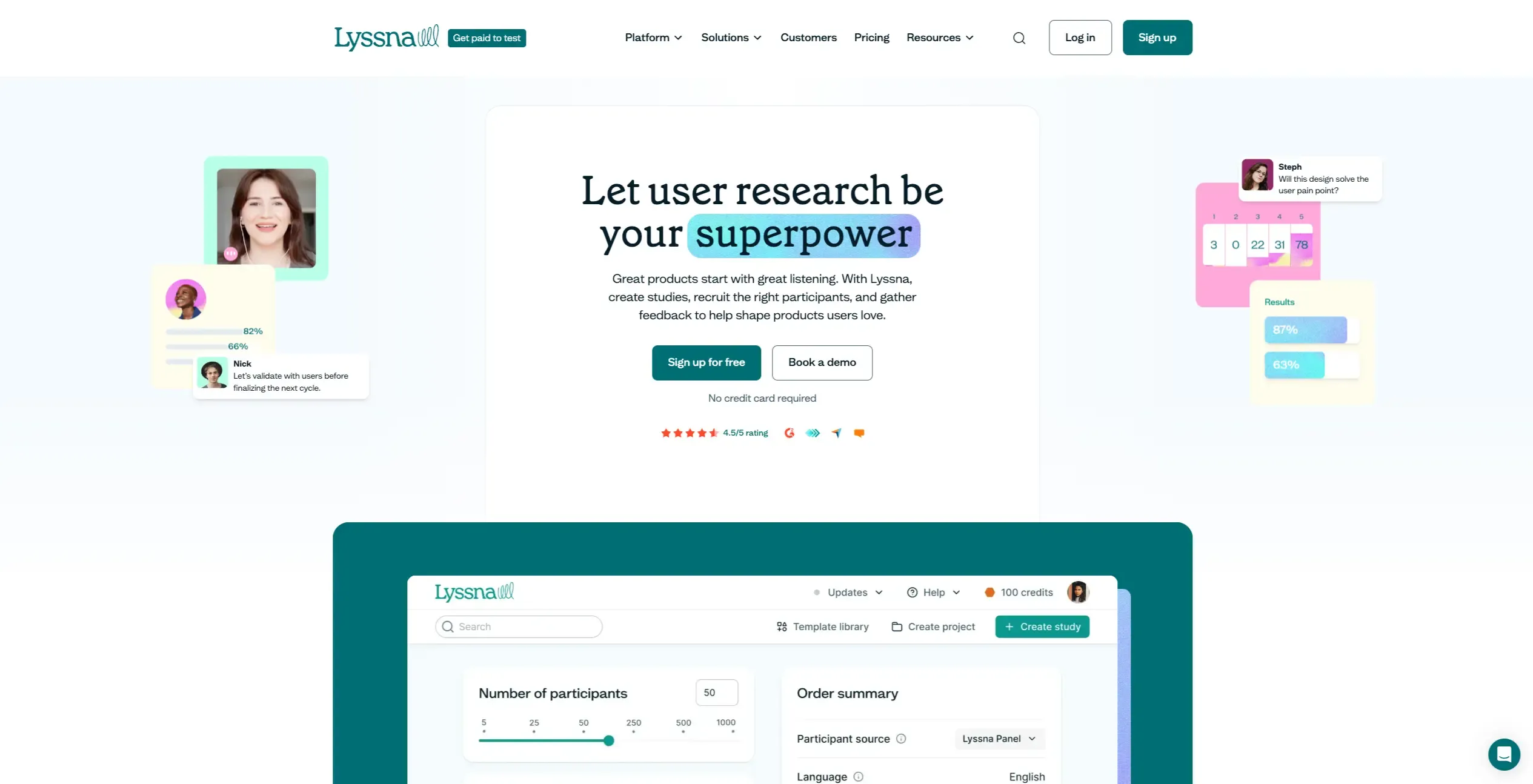
With Lyssna, crafting and delivering impactful UX survey questions is simpler than ever. Whether you’re it’s a quick survey or an in-depth study, the benefits of UX surveys with Lyssna are clear: faster insights, better-targeted feedback, and tools that scale with your needs.
Key features
Multiple survey options: Lyssna offers both text-based and design surveys. Design surveys allow you to ask questions while keeping your design front and center, making them ideal for gathering feedback about a design or for concept testing UX research.
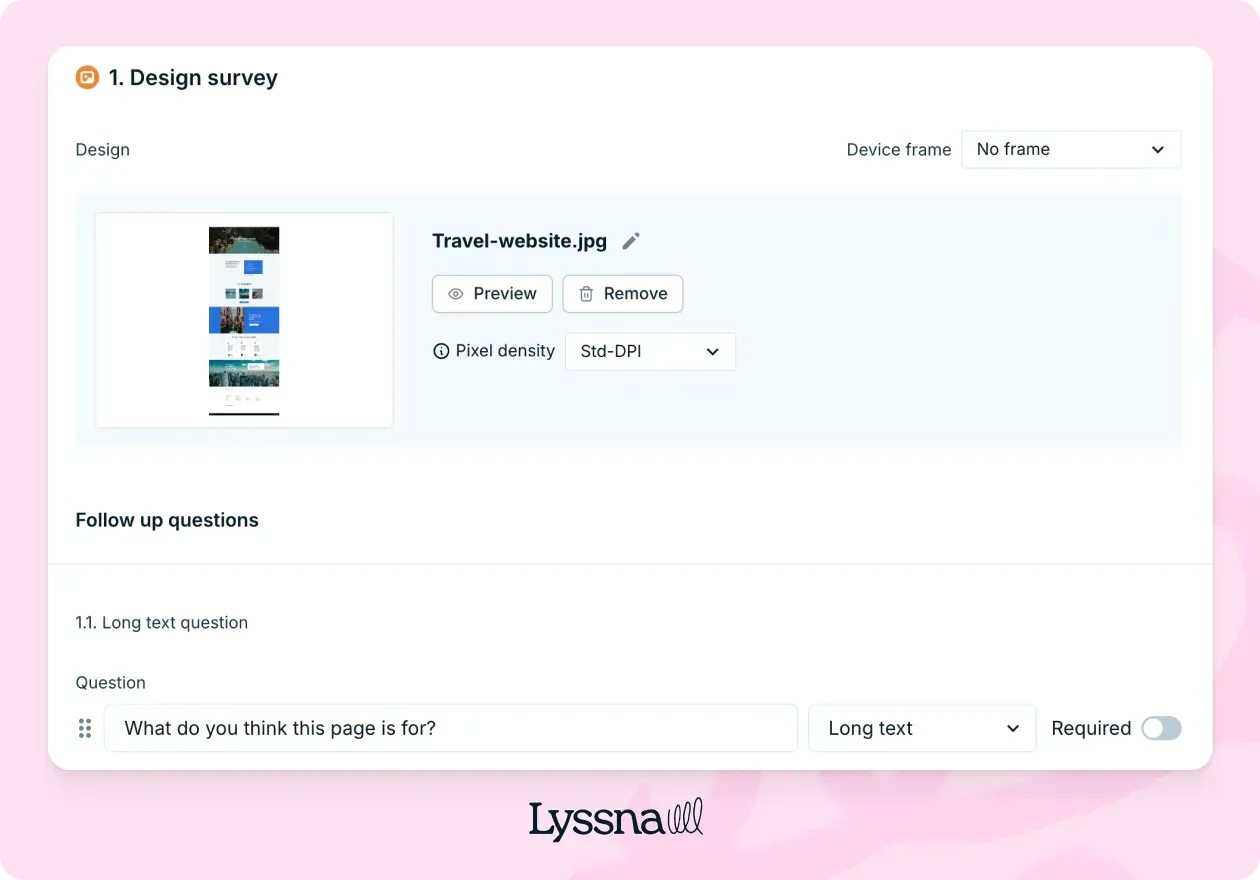
Multiple question types: Choose from different survey question styles, such as open-text, single and multiple-choice, linear, and ranking scale questions.
Apply test logic: Logic allows you to show or hide questions depending on answers to previous questions. This helps you ask more specific questions and make sure participants see questions that are relevant to them based on previous responses.
Multimedia support: Add video, audio, images, and more to your surveys, with support for a variety of file formats.
Simple survey data analysis: Analyze survey results quickly with real-time data visualization. Tag open-text responses and filter test results to understand patterns and themes. You can also share your results with a link and download results as a CSV.
Ease of use: Highly-rated on G2 for a simple and intuitive user interface, which saves you time with complex setups. You can launch surveys quickly, using either templates or custom questions.
All-in-one research: Besides surveys, Lyssna supports usability tests and user interviews, giving you the full UX research report at your disposal.
Participant recruitment: Recruit from a research panel of over 690,000 participants with specific targeting options. You also have the flexibility to ask UX screener questions to make sure you recruit the most suitable respondents.
Fast turnaround: Survey responses are collected within minutes or hours, not days, so you can quickly act on the data you collect.
Pricing
Free plan: Generous free plan with up to three seats. You can test with any method Lyssna offers on the free plan.
Starter: Starting at $82/month. Includes five seats, AI follow-up questions, and custom welcome and thank you messages.
Growth: Starting at $165/month. Includes everything in the Starter plan, plus up to fifteen seats and AI-generated summaries.
Enterprise plan: Pricing is tailored to your company and includes unlimited collaborators, security audits, and additional security integration.
Panel responses are priced separately for all plans.
What users are saying about Lyssna
G2 rating: 4.5/5
“Lyssna makes user testing incredibly easy with its straightforward, intuitive interface. From the moment you sign in, the platform guides you through the setup process with minimal friction. Implementing tests is a breeze, with simple step-by-step instructions and pre-configured templates that save a lot of time. The ease of gathering feedback and analyzing results is impressive, making it an efficient tool for both beginners and experienced testers alike.” (Jeremiah - Product Manager)
“Lyssna has enabled us to get answers to sticky design questions right when we need them. Particularly useful when we are mid-sprint and need a fast feedback.” (Laurence, enterprise manager)
Summary
With options for custom UX survey questions and powerful data visualizations, Lyssna enables you to gather and interpret user feedback quickly. Its all-in-one platform supports not only surveys but also usability testing, participant screening, and recruitment, making it the top choice for UX teams who need fast, accurate insights to inform product decisions.
Streamline your surveys instantly
Save time and get quick feedback! Browse our pre-built survey templates and cut your research setup time in half. Get started now and transform how you gather user feedback.
2. Typeform

Typeform is best known for its ability to create engaging, interactive surveys that feel more like conversations than traditional forms. This can help improve user engagement and response rates.
Key features
Conversational form design: A focus on creating engaging, user-friendly forms that encourage thoughtful responses.
Conditional logic: Customize the survey experience by showing different questions based on prior answers.
Mobile-optimized: Forms look good on all devices, ensuring a consistent user experience.
Seamless integrations: Works with tools like Google Sheets, Slack, and Zapier for easy automation.
Pricing
Free plan available with limited features; paid plans start at $29/month for more responses and additional features.
What users are saying about Typeform
G2 rating: 4.5/5
“Typeform was fast and easy to use. No struggling to figure out how it works.” (Michele D P.)
“I would like to see more analytical tools to help with analysis of results and conclusions.” (Roger W.)
Summary
You can use Typeform to create engaging, conversational forms, but it has limited tools for UX-focused feedback collection. Lyssna includes conditional logic in surveys, tailoring questions based on previous responses to collect more nuanced, UX-relevant data.
3. Condens
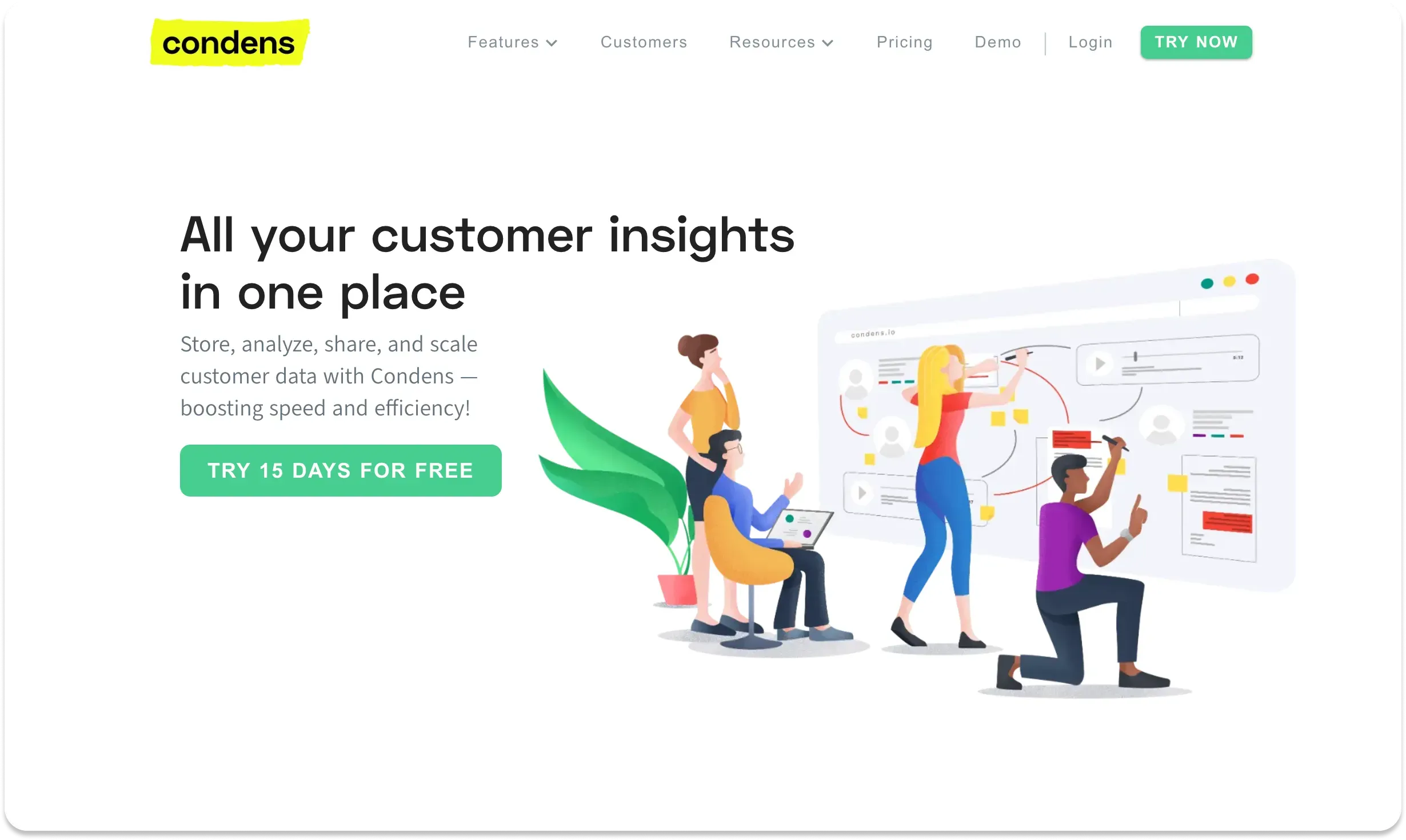
Condens supports the organization and analysis of qualitative survey data, interviews, and usability tests, making it a solid choice for teams focused on in-depth feedback categorization and review.
Key features
Collaborative data analysis: Share insights across teams and centralize all your research data in one place.
Efficient tagging and annotation: Makes it easy to tag and categorize data, allowing you to quickly make insights.
Integration with popular tools: Sync your research data with platforms like Slack and Jira.
Pricing
Starts at $15/month for individuals; team plans start at $190/month and provide additional collaboration features.
What users are saying about Condens
G2 rating: 4.8/5
“The tagging system is straightforward and leads to extremely rich cross-referencing and theme combinations.” (Marie-Cecile G.)
“The architecture is not the most user-friendly one; if you are new, you need to learn how to get your way around.” (Laura R.)
Summary
Condens is a strong option for organizing qualitative feedback but lacks built-in survey creation tools. Lyssna offers comprehensive UX survey creation capabilities (including multimedia support), allowing you to embed videos, images, and audio for richer user insights.
4. SurveyMonkey

SurveyMonkey is a flexible tool for general-purpose surveys. Its pre-built templates and integration options make it easy to gather feedback, conduct market research, and test user preferences.
Key features
Customizable survey templates: Pre-designed templates for various survey types help you get started quickly.
Powerful reporting tools: Dashboards and analytics give you a quick overview of trends and insights.
Advanced survey logic: Features like skip logic and question branching for more detailed responses.
Robust integrations: Connect with popular tools like Salesforce, HubSpot, and Mailchimp for seamless data flow.
Pricing
Individual plans start at $32/month, and team plans at $23/month (for a minimum of 3 users).
What users are saying about SurveyMonkey
G2 rating: 4.4/5
“Great for a low-budget solution.” (Tricia T).
“The ability to analyze needs to be improved, especially when trying to compare different variables among different surveys.” (Shaun T.)
Summary
SurveyMonkey is a great tool for generic surveys, but if you're looking for more in-depth research features (like the ability to conduct UX testing or recruit from a research panel), Lyssna might be a better option for you.
5. Jotform
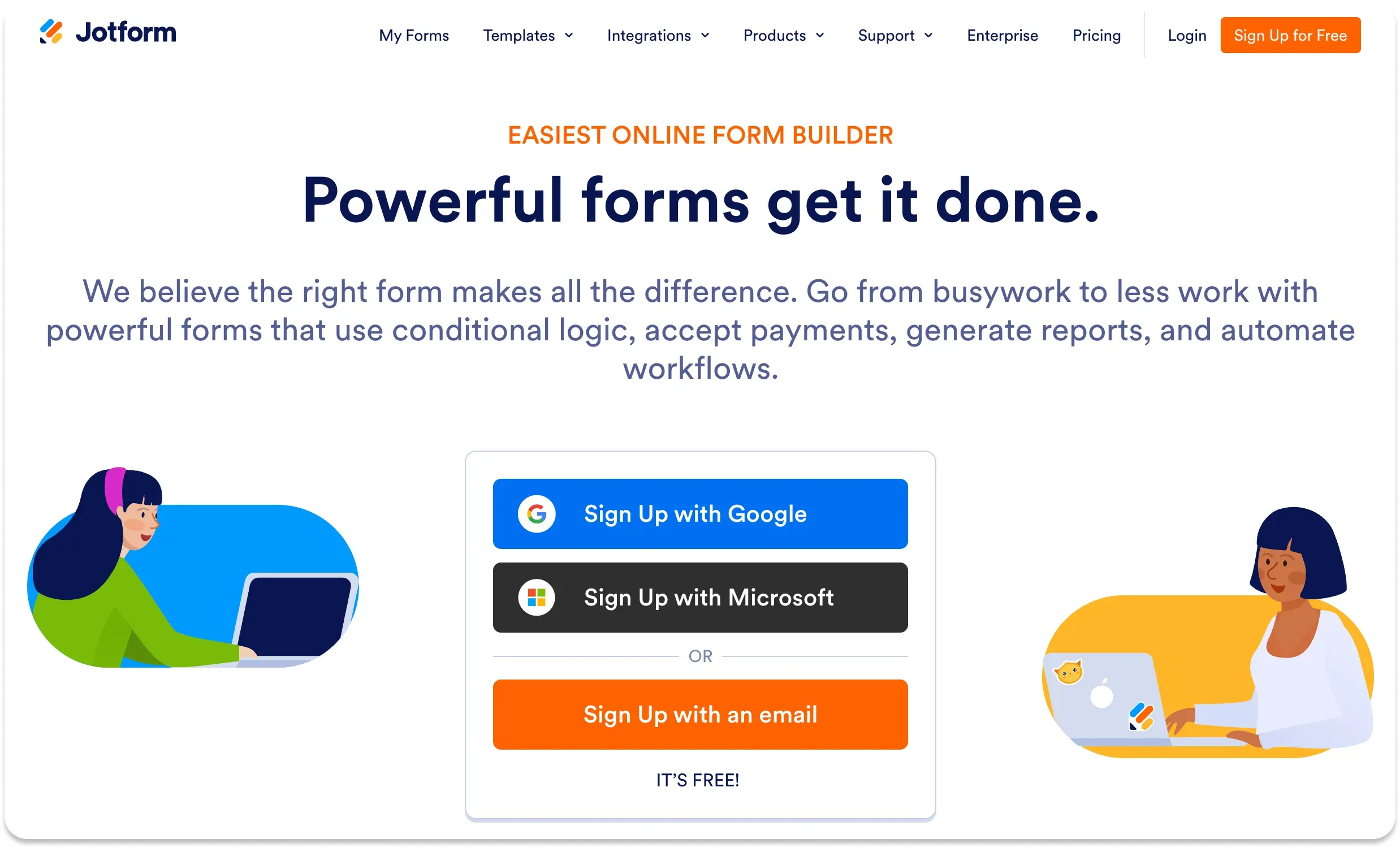
Jotform is a decent option for users needing customizable forms with plenty of design flexibility. It allows you to build complex forms with drag-and-drop simplicity and integrates well with other business tools.
Key features
Drag-and-drop form builder: Create forms easily with its visual builder.
Advanced customization: Offers detailed control over form layout, question types, and conditional logic.
Data management: Automatically stores and organizes form responses for easy review.
Automation: Integrates with over 100 apps, such as Dropbox, Google Drive, and PayPal, for workflow automation.
Pricing
Free plan with basic features; paid plans start at $34/month, with discounts for non-profits and educational institutions.
What users are saying about Jotform
G2 rating: 4.7/5
“Jotform is a flexible and user-friendly set of tools.” (Barry T.)
“For personal usage, the free plan is limited, and the premium ones, if you're not part of a large enterprise, tend to be very pricey.” (Melody M.)
Summary
Jotform offers extensive form customization but doesn't focus on UX data collection. Lyssna supports participant recruitment directly through the platform, giving you quicker access to users matching your target personas without needing third-party services.
6. Qualtrics
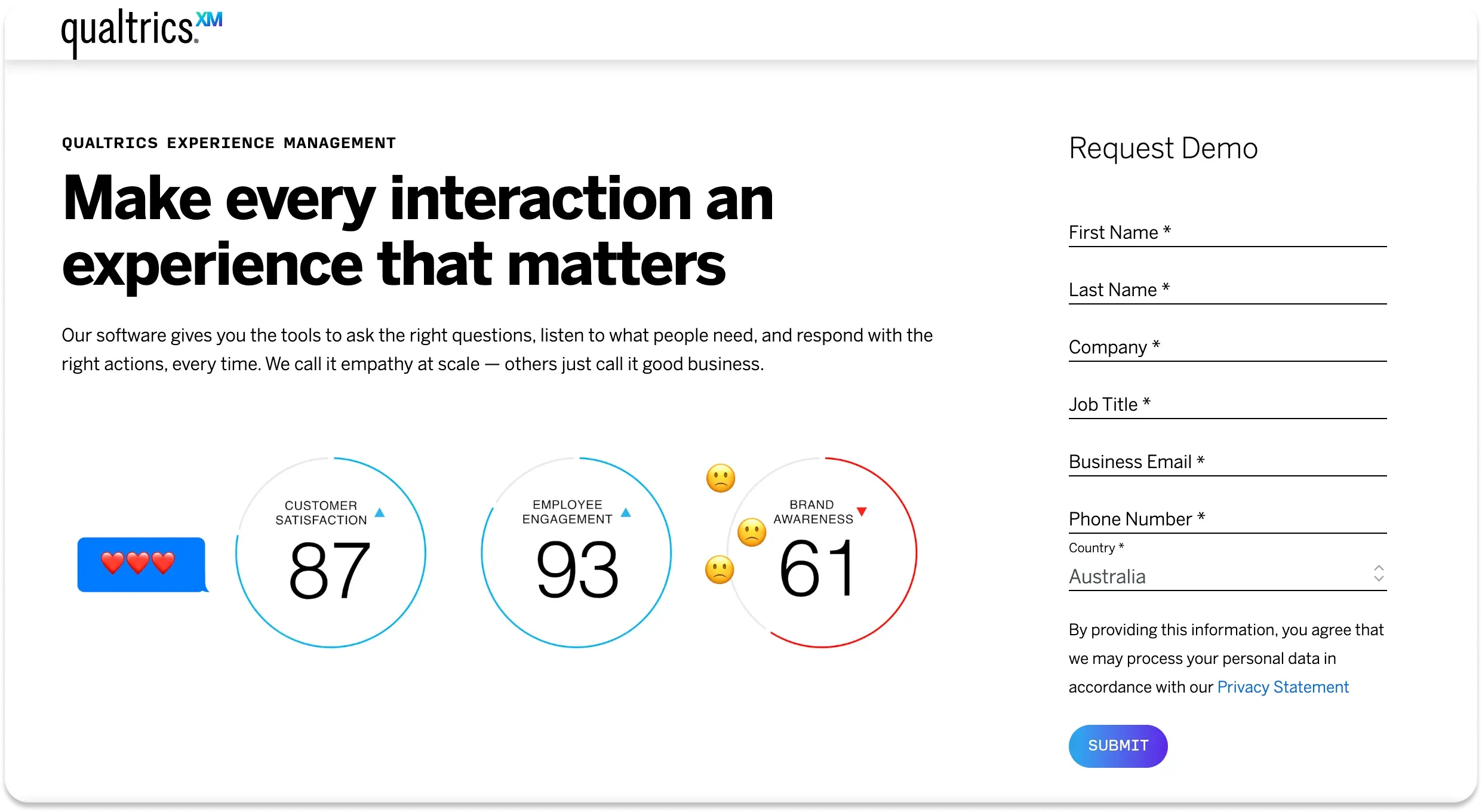
Qualtrics is a premium survey tool designed for enterprise-level research. It's highly customizable, allowing teams to create complex surveys with advanced logic and robust analytics.
Key features
Advanced analytics tools: Built-in dashboards and AI-powered analytics help you dive deep into your survey data.
Enterprise-level security: SOC 2, GDPR, and HIPAA compliant, making it ideal for sensitive data.
Customizable survey logic: Supports complex survey paths and response mapping.
Collaborative insights: Share findings across your organization with detailed reporting tools.
Pricing
Qualtrics pricing is customized and available by contacting their sales and service team.
What users are saying about Qualtrics
G2 rating: 4.4/5
“Qualtrics CoreXM offers an intuitive experience for creating and managing surveys and customer feedback. Its powerful analytics tools provide actionable insights, which has customizable templates and easy-to-use dashboards streamline data collection, making it ideal for informed decision-making and customer experience improvement.” (Sabramanian C.)
“I don't like that if you want some of the most interesting options, you have to buy the premium level of the software. I also think it should have more options to customize the appearance of our surveys.” (Richard S.)
Summary
While Qualtrics offers powerful features for large organizations, its cost may be prohibitive for smaller teams. Lyssna provides a more affordable option.
7. Alchemer
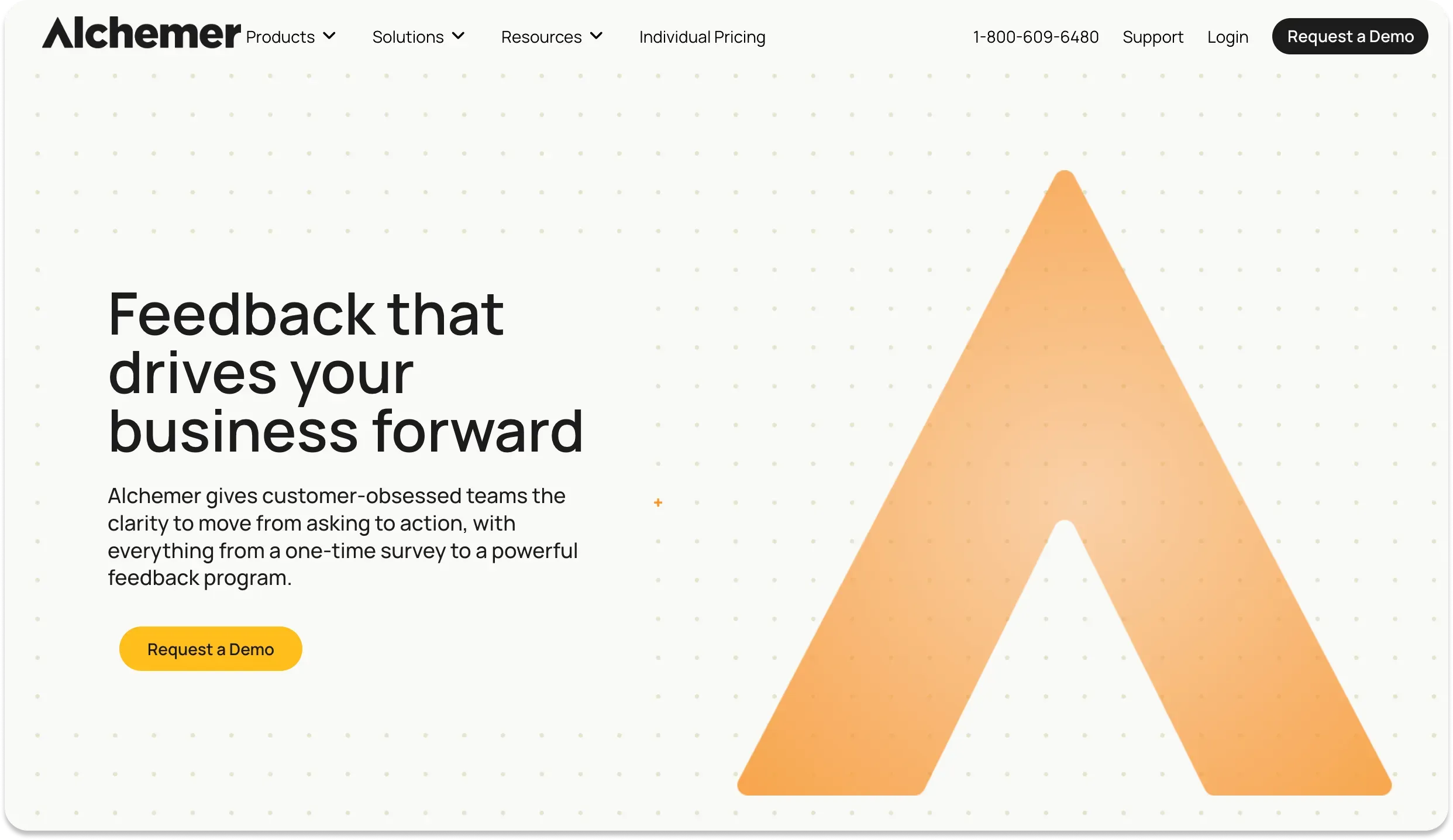
Previously known as SurveyGizmo, Alchemer provides flexible survey customization with powerful logic and design control.
Key features
Advanced logic controls: Create intricate survey flows based on user responses.
Custom branding: Tailor the look and feel of your surveys to align with your brand.
Collaborative tools: Work with your team on survey creation and analysis.
Multiple data export options: Export your data in several formats, including CSV and SPSS.
Pricing
Their basic Collaborator package starts at $55/month, with higher-tier plans offering more advanced customization.
What users are saying about Alchemer
G2 rating: 4.4/5
“It does everything I need it to do. It's pretty simple to accomplish most everything I need, and I'm able to find good documentation for when I need to do something new.” (Nathan P.)
“For their basic features I find Alchemer easier to use, however alchemer's advanced features may not be as good as the bigger platforms. Also some of the more specialized question types and picture questions can have issues.” (Andrew T.)
Summary
Alchemer offers strong survey customization and third-party recruitment options, but lacks Lyssna’s speed and agility for fast, actionable feedback.
8. SurveyLegend
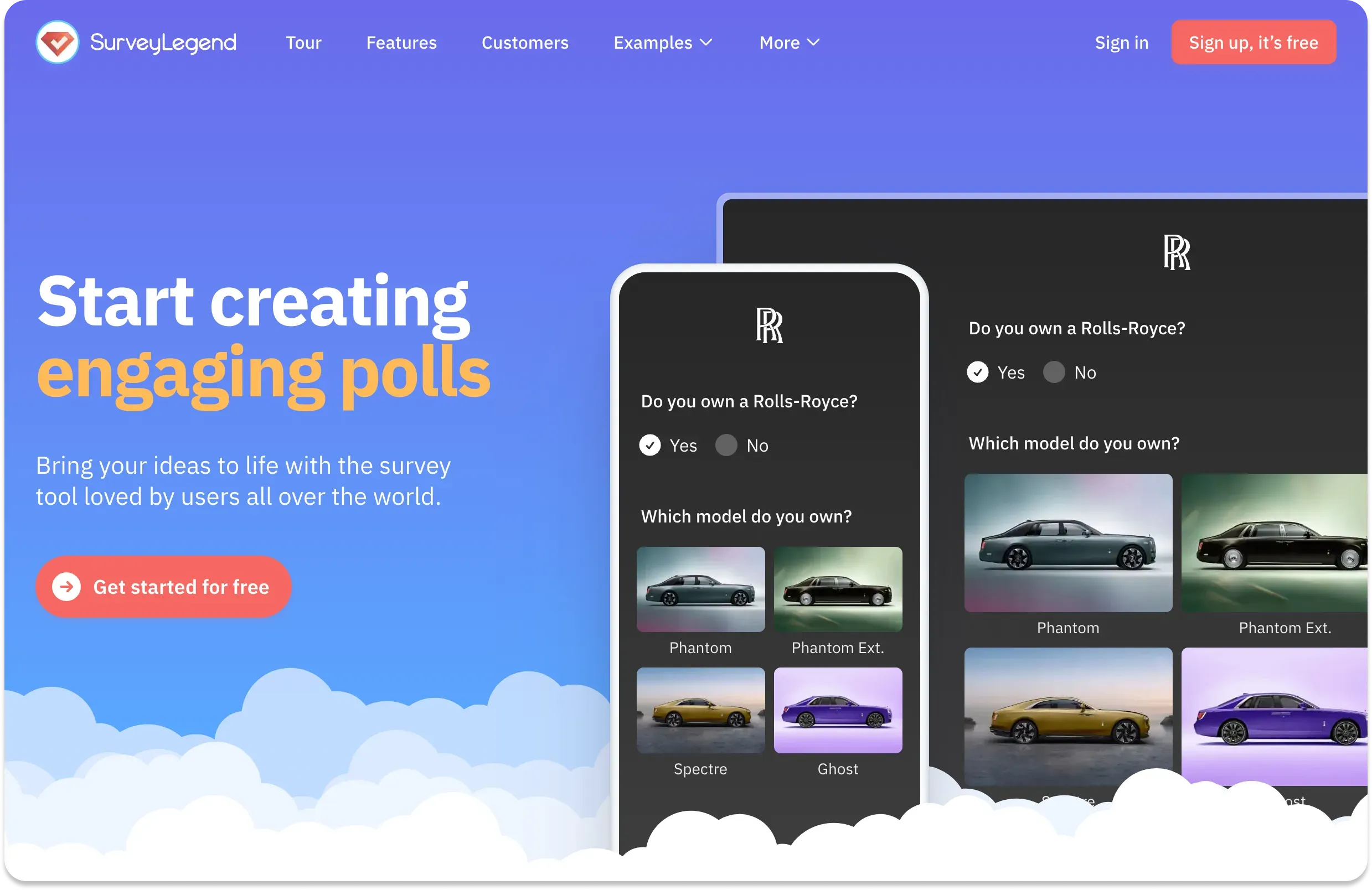
SurveyLegend focuses on creating visually arresting surveys that prioritize user experience.
Key features:
Beautiful survey design: Offers a range of customizable, eye-catching templates designed to improve user engagement.
Drag-and-drop survey builder: An intuitive design interface that makes creating and editing surveys easy.
Real-time data: Track responses in real-time with visual analytics and dashboards.
Mobile-ready: All surveys are optimized for mobile, so respondents can easily participate on any device.
Pricing
A free plan is available with limited features; paid business plans start at $25/month for more advanced design options and branding features.
What users are saying about SurveyLegend
G2 rating: 4.4/5
“Surveys are easy to setup and graphics are really nice.” (Verified G2 user)
“Good for basic survey needs” (Brittanie D.)
Summary
SurveyLegend is great for visually appealing surveys but lacks advanced analytics. Lyssna combines aesthetic survey design with powerful data analysis and recruitment tools, making it a more robust option for UX teams.
9. Google Forms
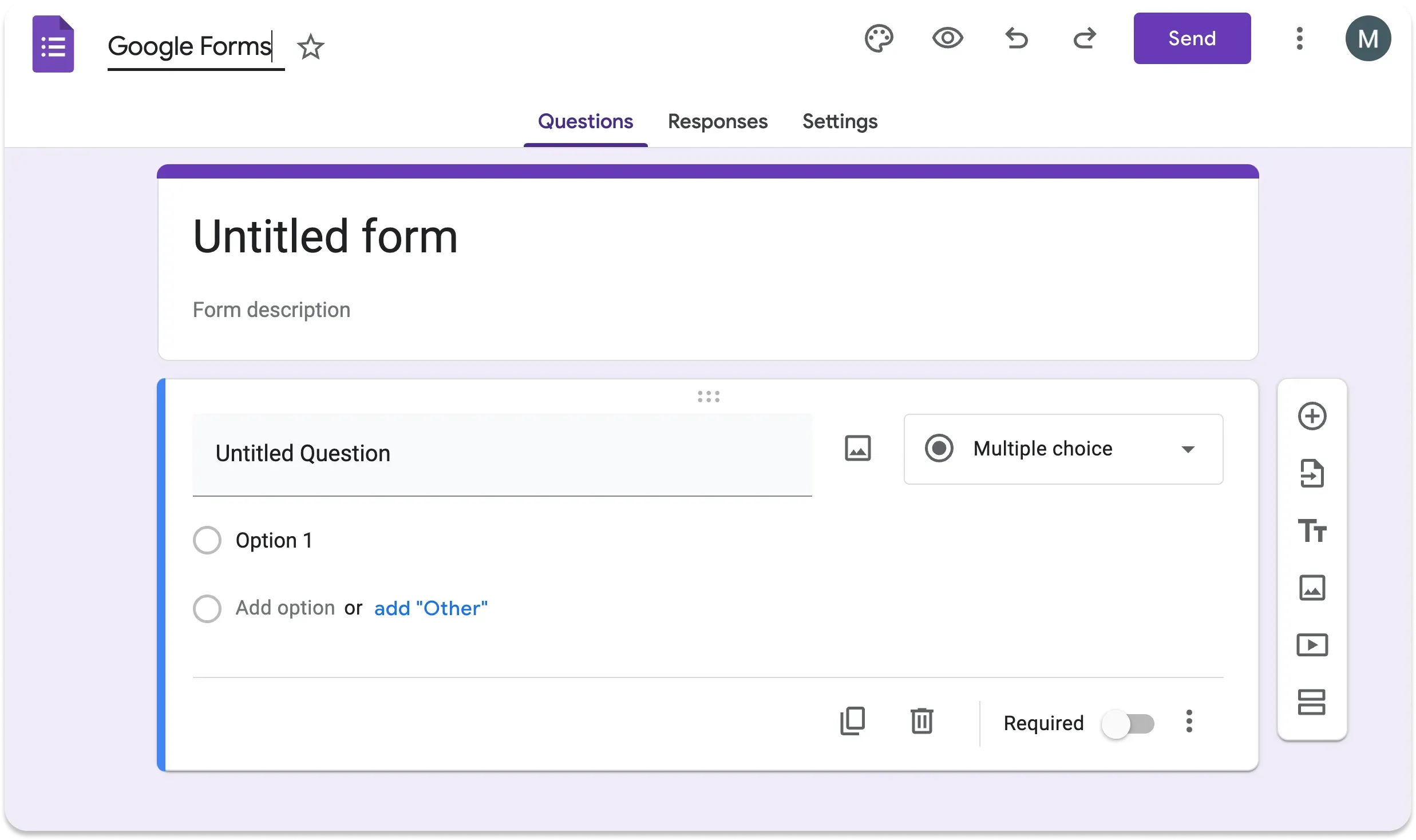
Google Forms is widely used for its simple, no-frills surveys. It’s free, easy to use, and integrates seamlessly with Google’s other tools, making it a go-to option for teams looking for basic survey functionality.
Key features
Free and easy to use: Google Forms is free and can be set up within minutes.
Basic customization options: Customize forms with different question types, logic branching, and themes.
Seamless integration with Google Suite: Automatically export data to Google Sheets for easy analysis and collaboration.
Collaboration features: Multiple users can edit forms and see results in real time.
Pricing
Free for all users, with storage limits tied to your Google account.
What users are saying about Google Forms
G2 rating: 4.6/5
“It allows everyone in the team to access it from any location which help us collaborate and work together even when some of us are working remotely.” (Robin M.)
“Lacks some advanced features compared to competitors.” (Maria L.)
Summary
While Google Forms is a good starting point for simple surveys, it lacks the advanced UX research tools offered by Lyssna (and, indeed, most of the other platforms here.)
10. Microsoft Forms
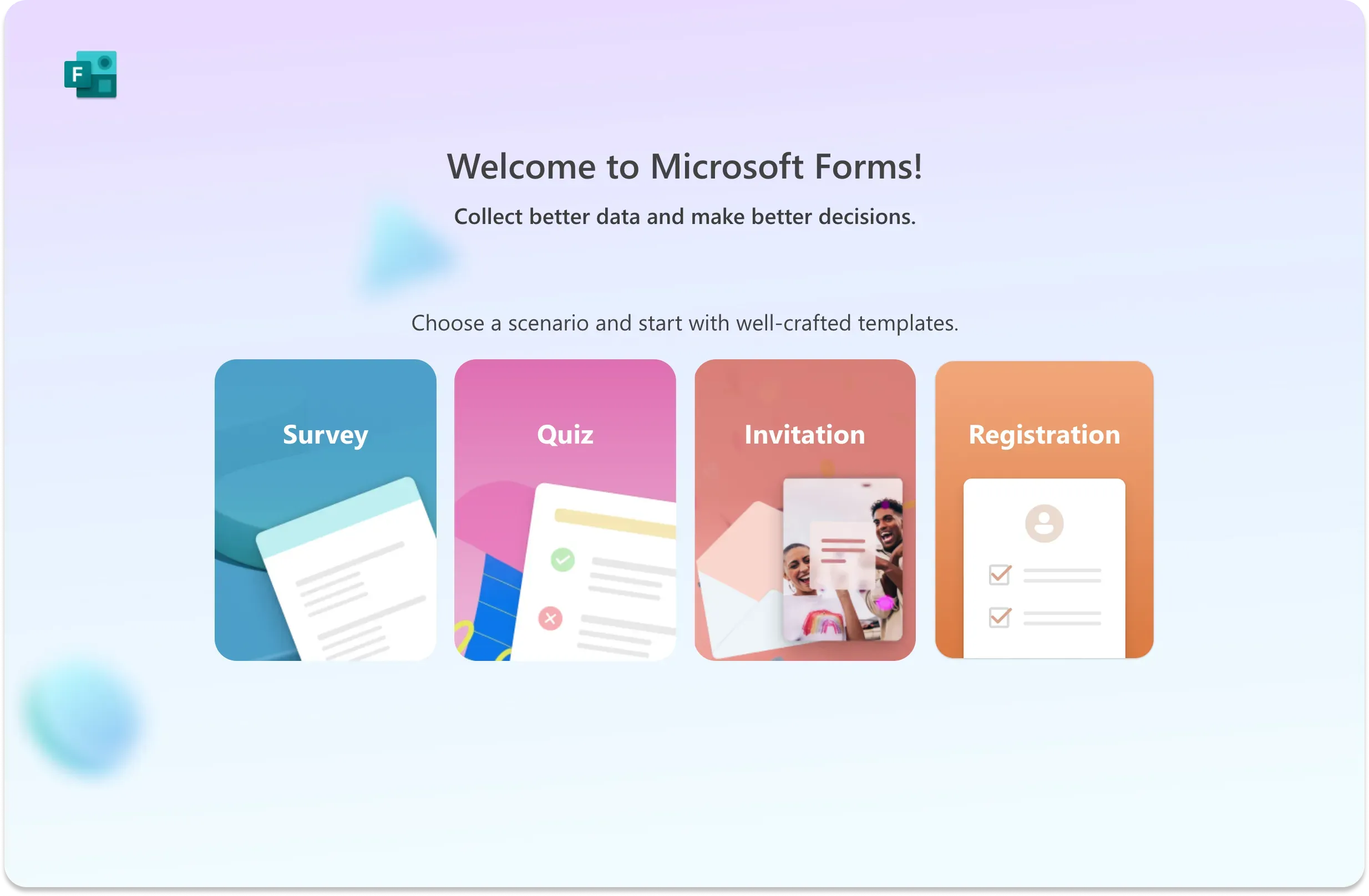
Similar to Google Forms, Microsoft Forms is a simple, easy-to-use tool for creating surveys, polls, and quizzes.
Key features
Quick survey creation: Pre-built templates and an intuitive interface make it easy to get started.
Real-time collaboration: Multiple users can work on surveys simultaneously and track responses in real time.
Integration with Microsoft 365: Responses can be easily exported to Excel, making data analysis straightforward.
Conditional branching: Set up simple survey logic to tailor questions based on previous responses.
Pricing
Free for Microsoft 365 users; no additional cost for existing subscriptions.
What users are saying about Microsoft Forms
G2 rating: 4.4/5
“I appreciate its versatility, as it can be used for a wide range of purposes, from quizzes to surveys, with various functionalities to choose from. The ability to update responses online is particularly valuable, especially when linked to reports or dashboards, ensuring real-time data synchronization.” (Verified G2 user.)
“There are lot of limitations in Microsoft Forms such as, number of questions asked in surveys, forms can not be saved for later use. The analytics which this platform provide is basic level and need to improve for better results.” (Kotla K.)
Summary
Microsoft Forms integrates well within the Microsoft ecosytem but has limited functionality for complex UX surveys. Lyssna supports survey-specific tools like conditional question paths and participant screening, helping you build more targeted surveys.
11. Survicate
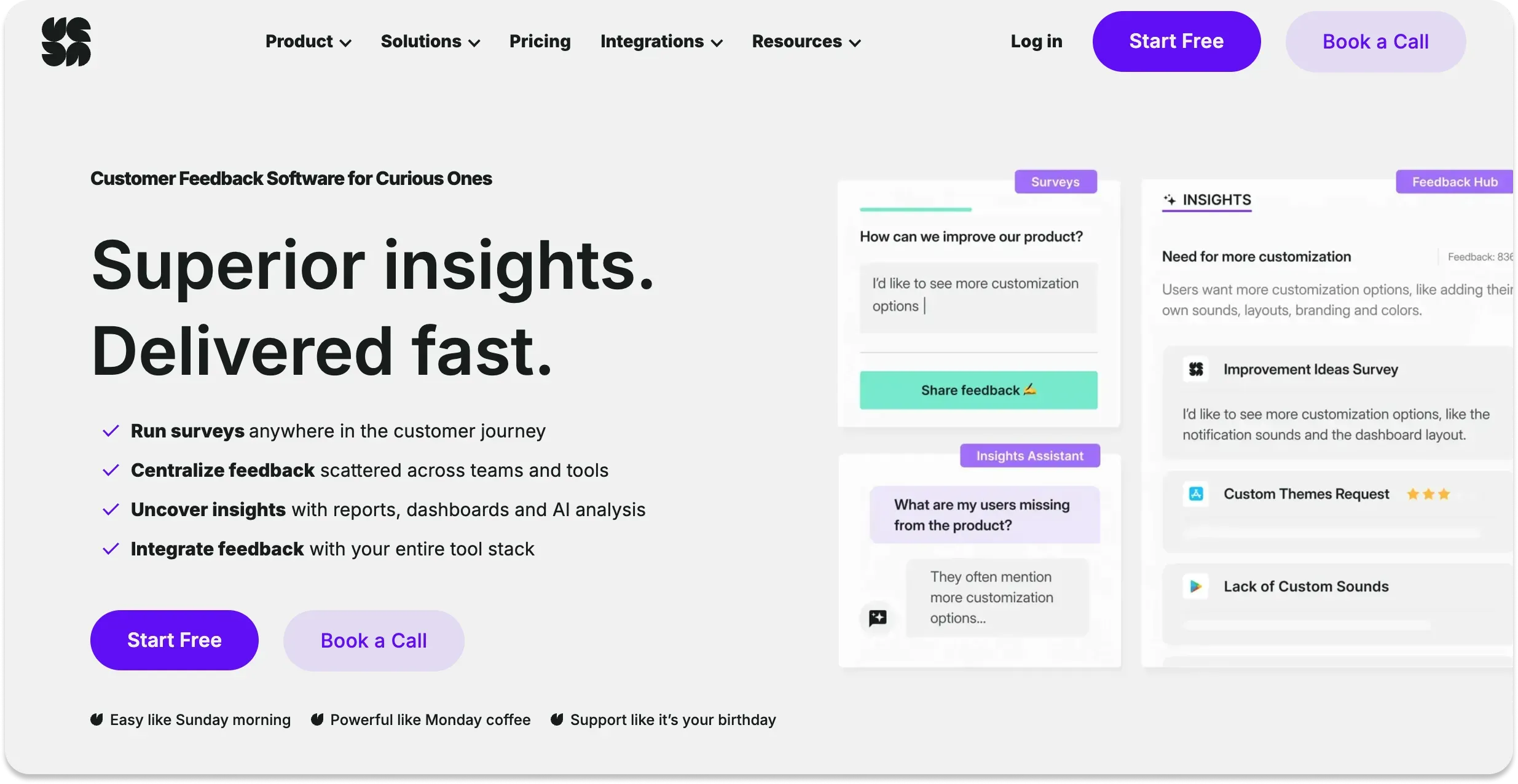
Survicate offers a variety of surveys, both in-app and on the web, for teams looking to capture feedback at different stages of the user journey.
Key features
In-app and website surveys: Collect user feedback directly within your product or on your website.
NPS, CSAT, and CES tracking: Measure customer satisfaction and user experience with built-in survey templates.
Multi-channel distribution: Send surveys via email, websites, mobile apps, and more.
Real-time feedback: Gather and analyze user responses in real time for actionable insights.
Pricing
Free plan available with limited features; paid plans start at $99/month for more advanced features and additional responses.
What users are saying about Survicate
G2 rating: 4.5/5
“I really like the practicality of installing surveys in my system and the ease of self-service control on the platform.” (Asafe R.)
“Survicate lacks advanced functionality, doesn’t provide feedback forums or updates about new features to its users.” (Suyash M.)
Summary
Survicate is useful for gathering in-app feedback but lacks tailored UX survey tools. Lyssna includes open-text response tagging and real-time response filtering, allowing UX researchers to quickly uncover themes and insights.
12. SurveySparrow
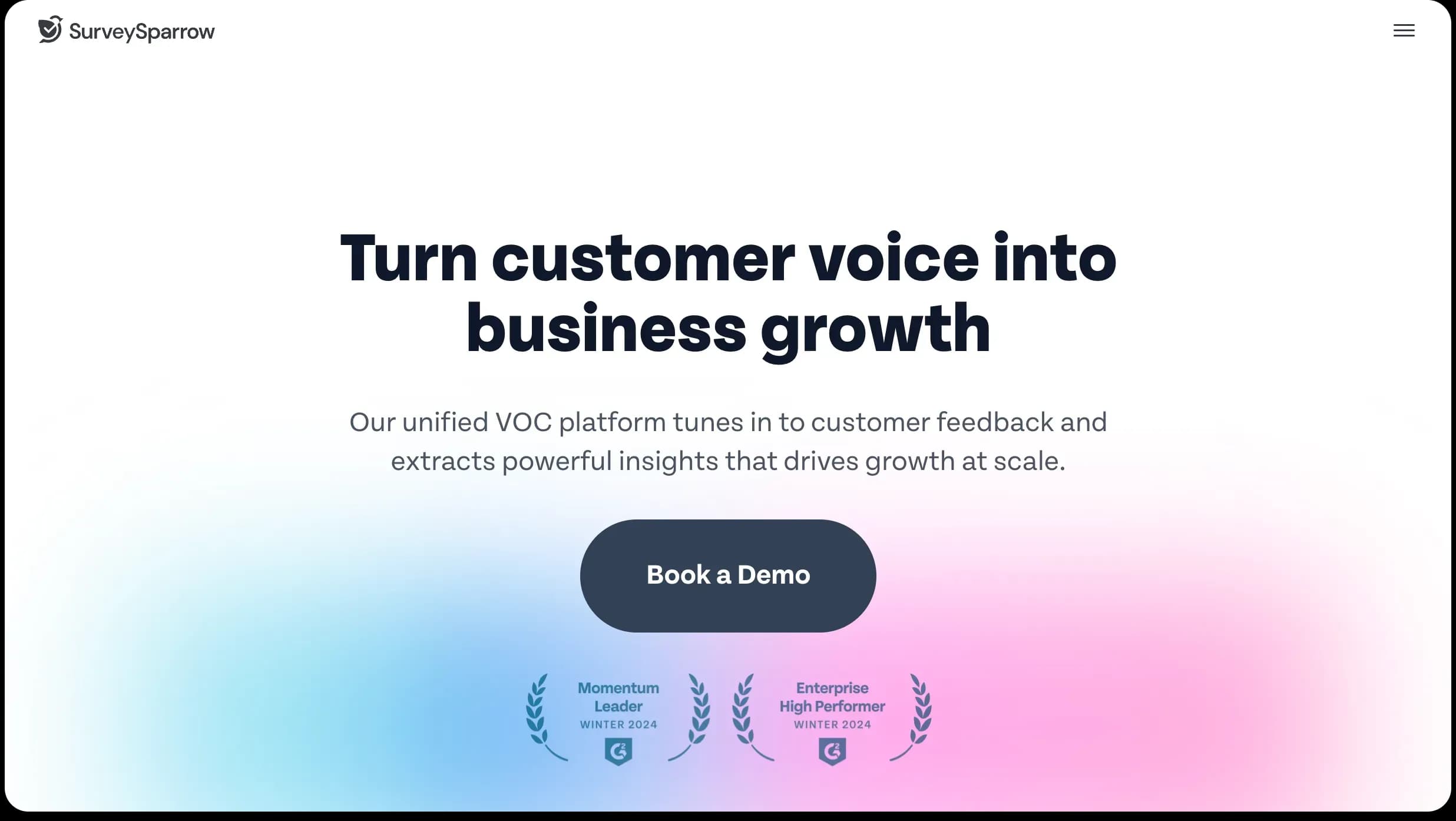
SurveySparrow is known for its conversational surveys that create an engaging experience for respondents. Its sleek, user-friendly interface encourages higher response rates and makes it easier for UX teams to gather actionable data.
Key features
Conversational surveys: Surveys feel more like conversations, improving engagement and response quality.
Multi-channel distribution: Share surveys via email, web, mobile, and social media platforms.
Recurring surveys: Automate and send recurring surveys to track customer or user satisfaction over time.
NPS and CSAT tracking: Built-in templates for Net Promoter Score (NPS) and Customer Satisfaction (CSAT) make measuring key UX metrics easy.
Pricing
Free plan available with limited features; paid plans start at $19/month.
What users are saying about SurveySparrow
G2 rating: 4.4/5
“It produces attractive surveys that are a good experience for the participant. The interface is fairly straightforward and attractive on the backend too.” (Claire Q.)
“Even with powerful integrations to our other tools. SurveySparrow lacks in key advanced analytics insight the platform, such as more advanced statistical analysis.” (Verified G2 user.)
Summary
SurveySparrow is engaging but has limited analysis tools. Lyssna makes it easy to find key themes in user feedback for more actionable insights.
13. Zoho Survey
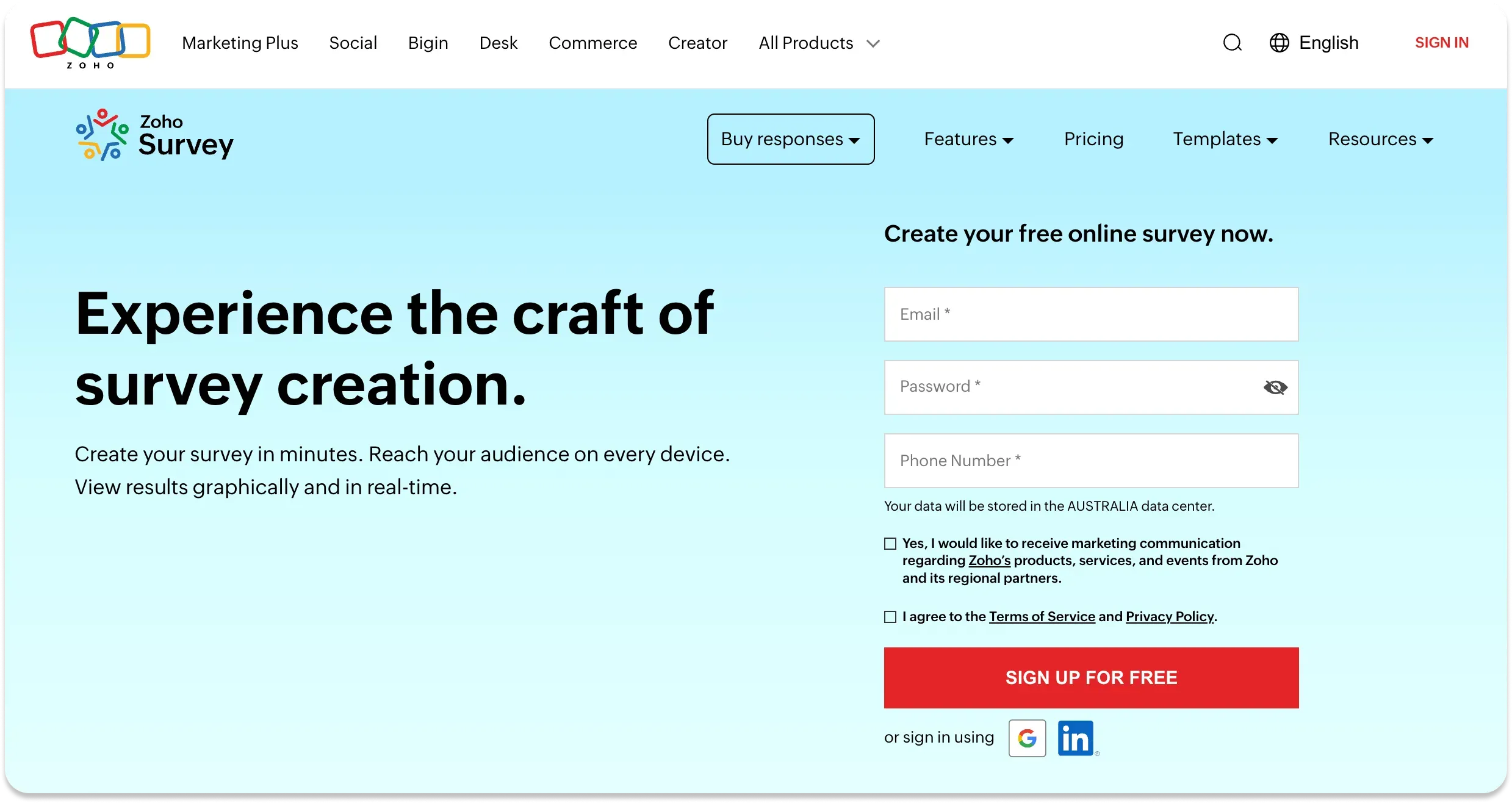
Zoho Survey is a robust platform that provides easy-to-use survey tools for businesses that need flexible survey options without the complexity of enterprise-grade tools.
Key features
Customizable templates: Choose from a variety of pre-built templates or create your own surveys from scratch.
Multi-channel distribution: Share surveys via email, social media, or embed them on your website.
Real-time reporting: Track responses and analyze survey data in real time, helping you make quick decisions.
Integration with Zoho ecosystem: Seamlessly integrates with other Zoho apps like Zoho CRM, making it a good option for businesses already using Zoho tools.
Pricing
Free plan available with basic features; paid plans start at $35/month for more advanced features like branding and detailed reporting.
What users are saying about Zoho Survey
G2 rating: 4.4/5
“Easy for users to create surveys without needing extensive technical knowledge.” (Sushma H.)
“Customer support is abysmal and requires significant clarification to the point of diagnosing the solution for them.” (Verified G2 user.)
Summary
Zoho Survey is recognized for its user-friendly interface and seamless integration within the Zoho suite. However, users have noted limitations in customization options and challenges integrating with non-Zoho applications. Lyssna offers advanced customization capabilities and broader integration options, enhancing its adaptability for diverse UX research needs.
14. Hotjar
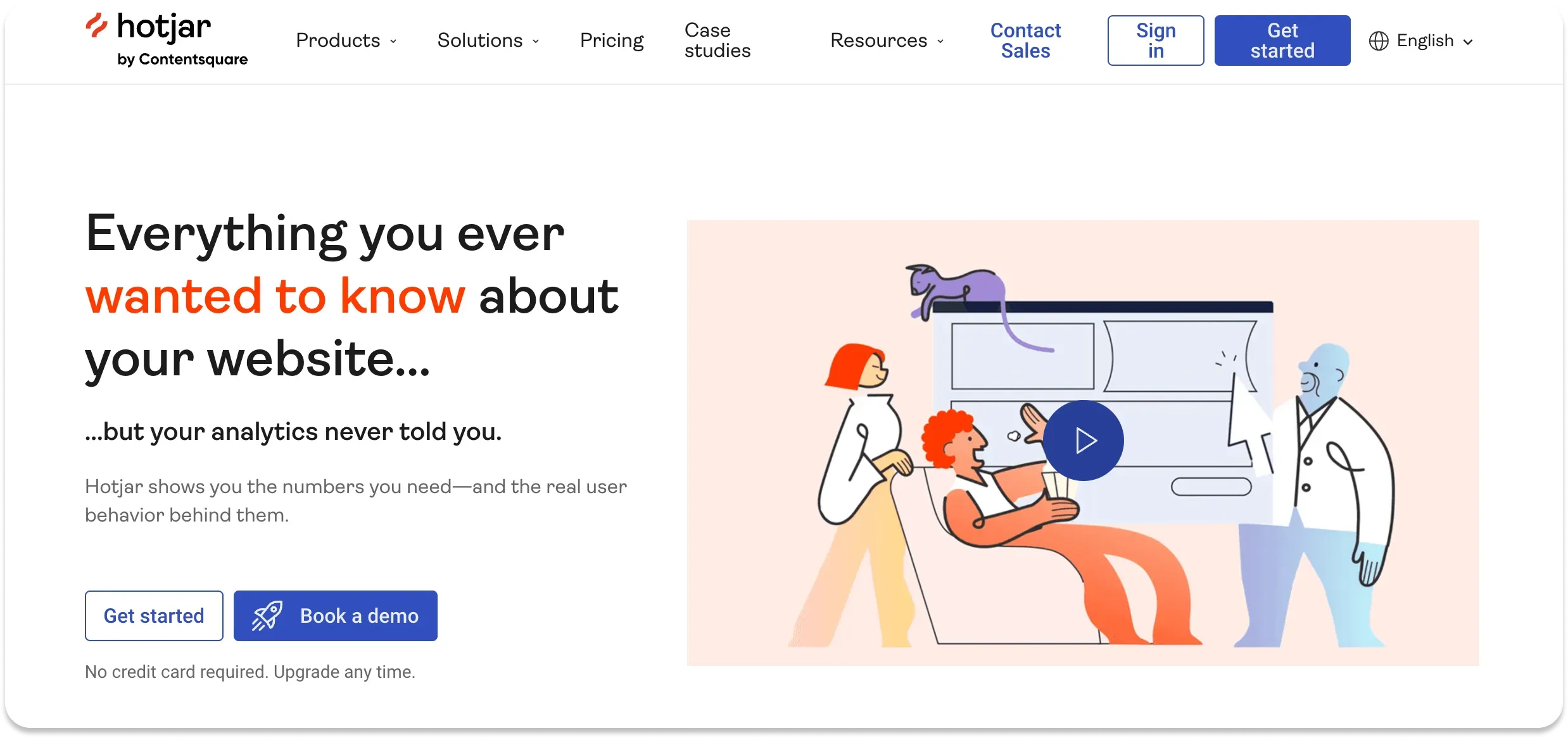
Hotjar is a powerful tool for gathering behavioral insights and collecting user feedback through heatmaps, session recordings, and on-site surveys.
Key features
On-site surveys: Create and deploy surveys directly on your website to collect contextual feedback, capturing users' thoughts as they interact with your product.
Exit-intent surveys: Engage users with a survey just before they leave your site, helping you understand why they didn’t convert.
Feedback widgets: Use customizable pop-up widgets to gather instant feedback without interrupting the user experience.
Behavioral analytics: In addition to surveys, Hotjar provides heatmaps and session recordings to visualize user interactions and discover friction points.
Pricing
Free plan with basic features; paid plans start at $39/month for advanced insights and more responses.
What users are saying about Hotjar
G2 rating: 4.3/5
“I've found the funnels and polls very useful in collecting user feedback.” (Joy C).
“Great to see the basic design of your website, and what people are clicking on.” (Verified G2. user).
Summary
Hotjar’s heatmaps and session recordings are excellent for understanding user behavior on websites, and its feedback tools, such as website feedback surveys, are easy to use. That said, advanced features can be costly, and there are limits on data segmentation. For teams focused on UX surveys, Lyssna offers more targeted survey tools, deeper data analysis, and participant recruitment, giving you more comprehensive insights for UX research.
Which survey tool is right for you?
From surveys that pop with visuals to analytics that dive deep into behavior, the tools we've explored cover a lot of ground. But if you’re after a single solution that hits the mark on affordability, quick participant recruitment, and powerful research, Lyssna stands apart.
It’s not just a survey tool (in the same way that Amazon’s not just a bookstore). It covers every step: design surveys, gather detailed feedback, and run usability tests all in one place. With Lyssna’s quick setup, intuitive interface, and powerful research tools, you can focus on what matters – getting insights that drive real improvements.
Ready to elevate your UX game? Lyssna is the platform where you’ll get all the right answers.
Sign up for a free plan today
No more research roadblocks. Experience our intuitive UX survey platform – with zero commitment. Create your first survey in minutes, recruit participants, and unlock actionable insights with Lyssna's free plan.
You may also like these articles


Try for free today
Join over 320,000+ marketers, designers, researchers, and product leaders who use Lyssna to make data-driven decisions.
No credit card required

